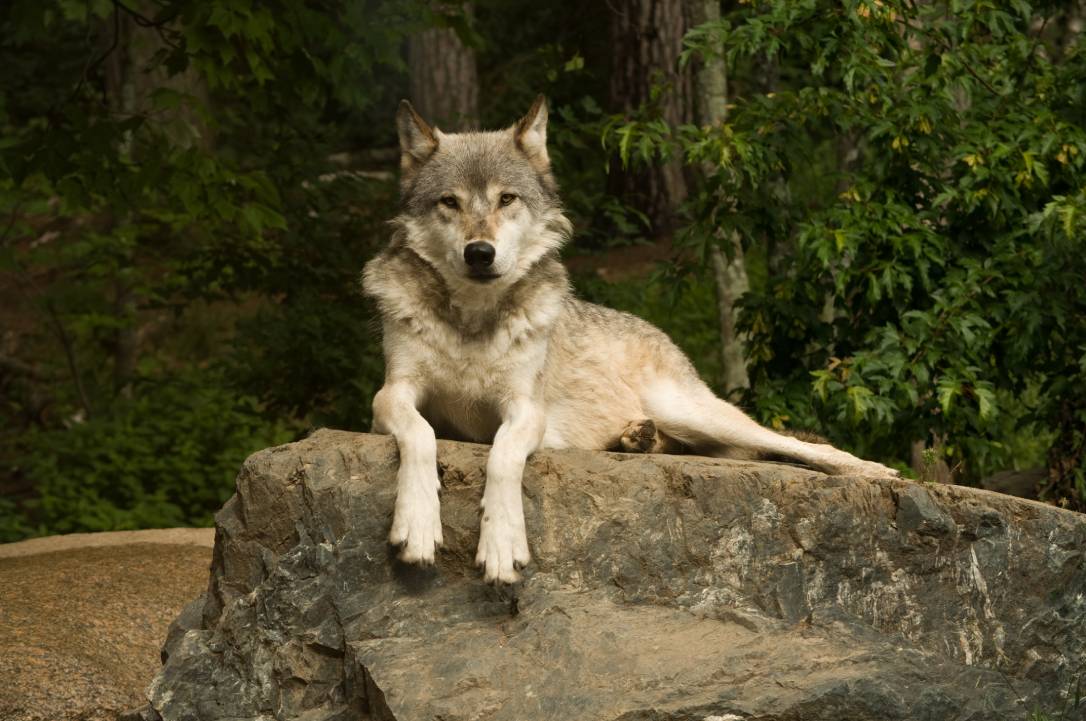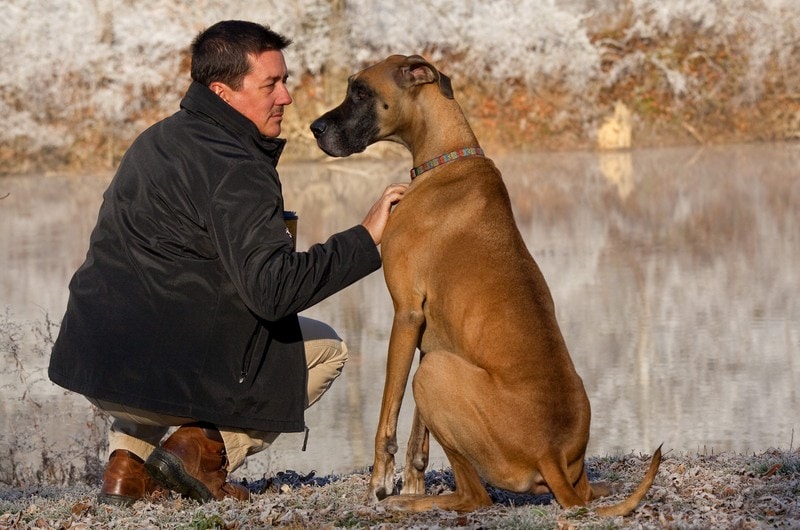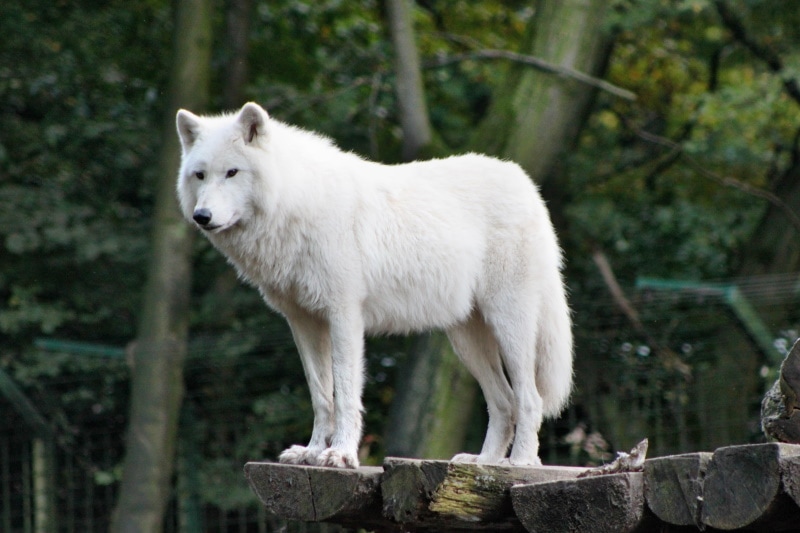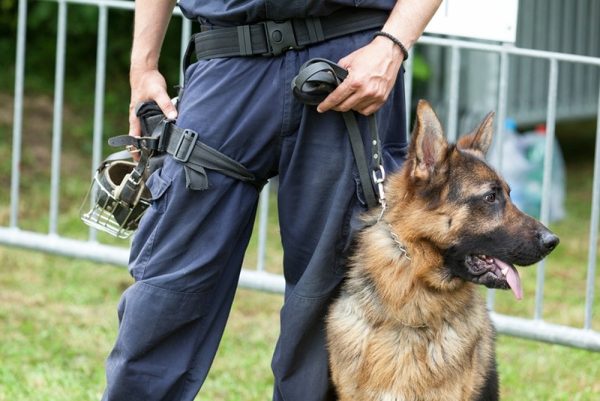Wolves are feared and held in awe, but they have been the subject of many movies, TV shows, and books. While they are often seen as villainous (such as in the story of Little Red Riding Hood), wolves are just animals—no more evil than your dog.
But how big are they compared to dogs? This depends on the dog, of course; wolves are among the largest in the canine family and are bigger than most dog breeds. But there are a few breeds of dogs that can give wolves a run for their money!
Below, we’ll discuss the size of wolves and dogs, which is particularly important because wolves are ancestors of our beloved pet dogs.

Are Wolves Bigger Than Dogs?

The largest wolf species is the Gray Wolf,1 also known as the Timber Wolf. The average male Gray Wolf can be 6.6 feet long, 30 inches tall at the shoulder, and weigh 100 pounds. Remember that this is just an average wolf; the largest Gray Wolf on record weighed about 175 pounds!
But how do they compare to dogs? Wolves are larger than most dogs, but a few extra-large breeds are bigger than wolves. For example, most Great Danes are taller and heavier than the average wolf. The following chart compares the height and weight of the Gray Wolf to a few other animals and humans to put the wolf’s size in perspective.
| Species | Height | Weight |
| Coyote | 23–26 inches | 20–50 pounds |
| Gray Wolf | 26–32 inches | 60–145 pounds |
| Great Dane | 28–32 inches | 110–175 pounds |
| Average Human | 69 inches | 198 pounds |
| Spotted Hyena | 30–32 inches | 88–190 pounds |
| Lion | 42–48 inches | 330–550 pounds |
As you can see, the wolf is technically smaller than the average Great Dane and human, but of course, everything depends on the size of the individual. There are many small and large dogs, as well as small and large wolves.
A Little About Wolves
Despite their name, Gray Wolves range in color from white to black, and most have gray or light brown fur. They are considered a keystone species, which essentially means they are critical to the ecosystem. Gray Wolves are the largest species of wolf, and the largest of these wolves are found in west-central Canada, Alaska, and northern Asia. The smallest Gray Wolves are located in the southern parts of their distribution, such as India and the Middle East.
The Gray Wolf is the most common wolf species, but the Red Wolf, the Eastern Wolf, and 40 subspecies have smaller populations. The Red Wolf is critically endangered and is only found around eastern North Carolina. As of July 2024, there are 18 collared Red Wolves in North Carolina and an estimated 19 to 21 in the wild. In a bid to save them from extinction, there are 263 Red Wolves in captivity as part of the Species Survival Plan.
The Eastern Wolf is only found around the Great Lakes and southeastern parts of Canada. They are small to medium in size and are reddish or light brown in color. They are also known as the Algonquin Wolf and the Timber Wolf (like the Gray).

What Are the Largest Dog Breeds?
The Great Dane is considered the largest dog breed, but several other breeds are nearly as big. The Dane is the largest by height (though sometimes challenged by the Irish Wolfhound), but the English Mastiff can be considered the biggest by weight. The following are 10 of the world’s largest breeds of dogs.
- Great Dane: They are definitely the tallest dogs on record. Great Danes stand an average of 32 inches tall and weigh up to 170 pounds. The world record for the tallest dog ever is for Zeus, a Great Dane that was 44 inches tall (3.5 feet tall)!
- English Mastiff: These dogs weigh an average of 150 to 250 pounds. An English Mastiff named Zorba was recorded as being the longest dog (8’3” from nose to tip) and the heaviest (343 pounds)!
- Neapolitan Mastiff: The Neapolitan is 26–31 inches tall and weighs an average of 130–155 pounds.
- Bullmastiff: Bullmastiffs weigh about 100–130 pounds and stand 27 inches at the shoulder.
- Saint Bernard: The lovable St. Bernard is an average of 27.5 inches tall and can weigh 140 to 260 pounds.
- Newfoundland: Newfies are big, lovable dogs that stand about 28 inches at the shoulder and weigh an average of 150 pounds.
- Cane Corso: The Cane (pronounced KAH-NAY) Corso is about 23 to 28 inches tall and weighs 88 to 120 pounds.
- French Mastiff: This Mastiff is 24 to 27 inches tall and can weigh an average of 150 pounds.
- Great Pyrenees: These giant white, fluffy dogs stand about 25 to 32 inches tall and weigh 90 to 130 pounds.
- Bernese Mountain Dog: Berners stand 25 to 27.5 inches tall and weigh about 100 to 160 pounds.

What Are the Main Differences Between Wolves and Dogs?
There are several differences between wolves and dogs, though you can see the resemblance when you look at a breed like the German Shepherd.
- Physical differences: Beyond the breeds that look nothing like wolves (Pugs, for example), there are other noteworthy differences. Wolves have large, strong skulls and jaws, as well as large paws. Wolves also have small eyes, pointed ears, and long sickle tails. Some dogs fit this description, but many breeds have floppy ears and short or curly tails.
- Rate of maturation: Wolves mature faster than dogs, which is necessary for their survival in the wild.
- Breeding differences: Wolves breed once a year, only from February to mid-March, and pups are born in April. They have litters of four to five pups, and the mother and father help raise the young.
- Problem solvers: Some studies have found that if a problem is too difficult to manage, dogs will turn to their owners for help. Wolves don’t have that luxury and are better at figuring out things for themselves.
- Shy: Wolves are shy creatures, particularly compared to dogs. This goes against how wolves have been portrayed in media, but most wolves will run from a person most of the time.
- Play: Dogs play for fun, and it is a form of mental and physical exercise that helps form a bond between the dog and the owner. Wolf pups play to learn social skills and survival techniques. They need to be efficient pack members and learn how to hunt.
- Nutrition: Wolves are carnivores, whereas dogs are omnivores. Wolves can go longer without meals and absorb nutrients differently than dogs. Neither species would thrive on the other’s diet.
- Human dependence: It’s clear that wolves have no dependence on us, while dogs certainly do. There are many cases where an attempt to train wolves and form a bond with them has failed. Wolves never exhibit any of the same behaviors as dogs.

Summary
Wolves are bigger than most dog breeds, but a few giant pups are even larger! However, while a few dog breeds resemble wolves and have a few other similarities, the differences between the two species are quite striking.
Wolves are beautiful animals that are essential to many of the world’s ecosystems. If you’d like to bring home a breed that reminds you of a wolf, consider adopting a Husky, Akita, Samoyed, Alaskan Malamute, or German Shepherd.
See Also:
Featured Image Credit: Piqsels


















